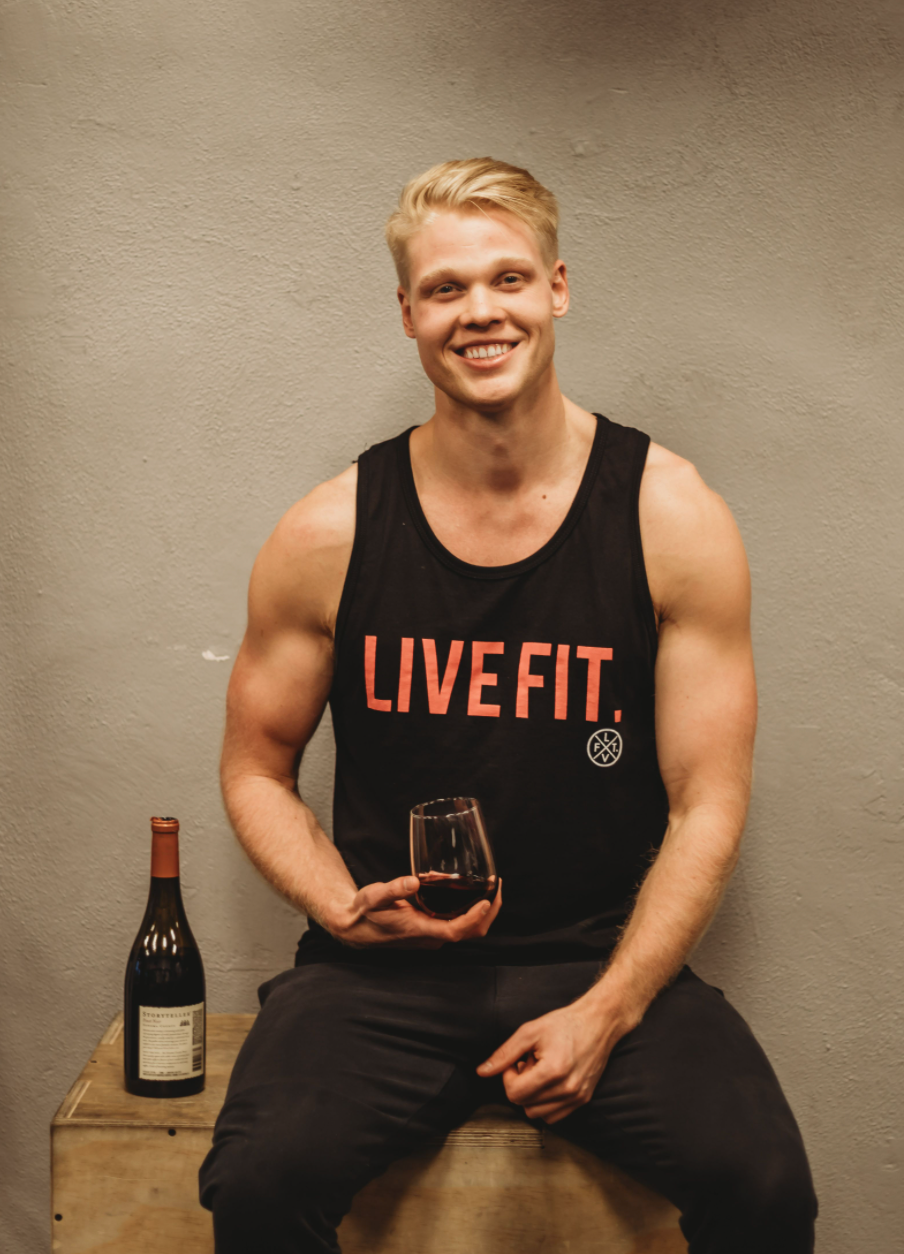Today, renowned physique coach Alex Bush and I embark on a deep dive into all things glute training, covering important topics like:
→ Why most people trying to grow glutes aren’t seeing results
→ How to tweak your execution to get the most out of every set in your glute training
→ How to choose the best movements for building glutes (along with a few of Alex’s personal favorites)
→ How to design a training day for maximum glute growth
…and much more.
This one is PACKED with so much knowledge from Alex you can take and immediately apply for better results from your glutes training.
If you'd rather listen to the podcast version of our interview, CLICK HERE.
[*Alex deserves credit for most of the points and concepts below. I've expanded on his thoughts a bit where helpful, but highly recommend you listen to the episode as well to fully understand the context of the conversation.]
THE MOST COMMON MISTAKES WOMEN TRYING TO BUILD THEIR GLUTES MAKE
1. Lack of focus on execution.
Basically, you're just looking at exercises as if they're destinations between point A and point B.
There are a lot of different movements we can use to add quality glute tissue, but too many people fall into the trap of thinking...
"Ok, I'm doing ___ movement, I'm automatically going to grow my glutes."
...which really isn't the case.
While doing "good glute exercises" will train your glutes, to get most of the benefits of said movement, you actually need to execute it properly.
EXAMPLE:
if done improperly, a barbell glute bridge will often turn into a movement that's mostly working the quads and lumbar spine. And while it's not like the glutes won't be working at all, they won't be the main driver or main muscle group being biased within the movement without proper execution.
2. Trying to do too much
After experiencing the stress/stimulus of a hard training session, there’s a large amount of recovery that must happen simply to get your muscles recovered back to their previous baseline - this has to happen before new growth can occur.
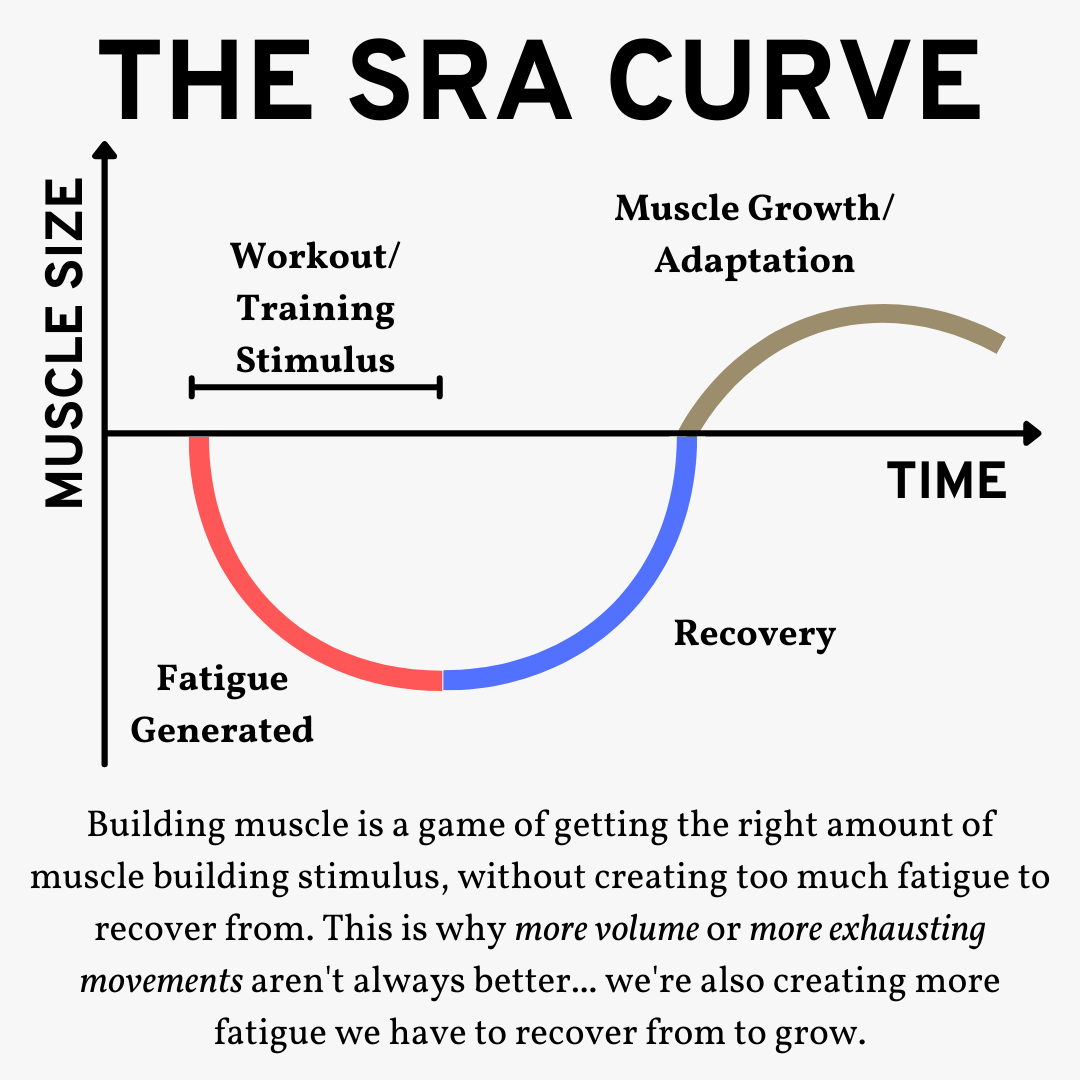
Some women are actually doing too much, which leads to your muscles barely being able to recover enough to get back to their previous baseline, due to the large amount of fatigue created in your training.
Now, some actually just need to push harder… but if you’re constantly crushing yourself in the gym but not seeing progress, doing less work so that you can actually recover may help.
3. Not eating enough food
The other side of this problem is under-fueling yourself. This is most often a situation where someone is trying to add a lot of muscle tissue to their glutes... while also trying to get leaner at the same time.
So essentially you're in a situation where you're doing a lot of volume (number of hard sets) for your glutes weekly, but you're also severely restricting your recovery resources (food).
Here, it's important to understand that you don't just grow from training hard... you grow from what you can actually recover from.
Lots of training volume + low calories = the recipe for no progress in most cases.
WHAT ARE THE PRIMARY MUSCLES OF THE GLUTES WE NEED TO TRAIN?
Our glutes are made up of a few different muscle groups, but the two we can actually see are:
1. The glute max. This provides the "pop" to your glute.
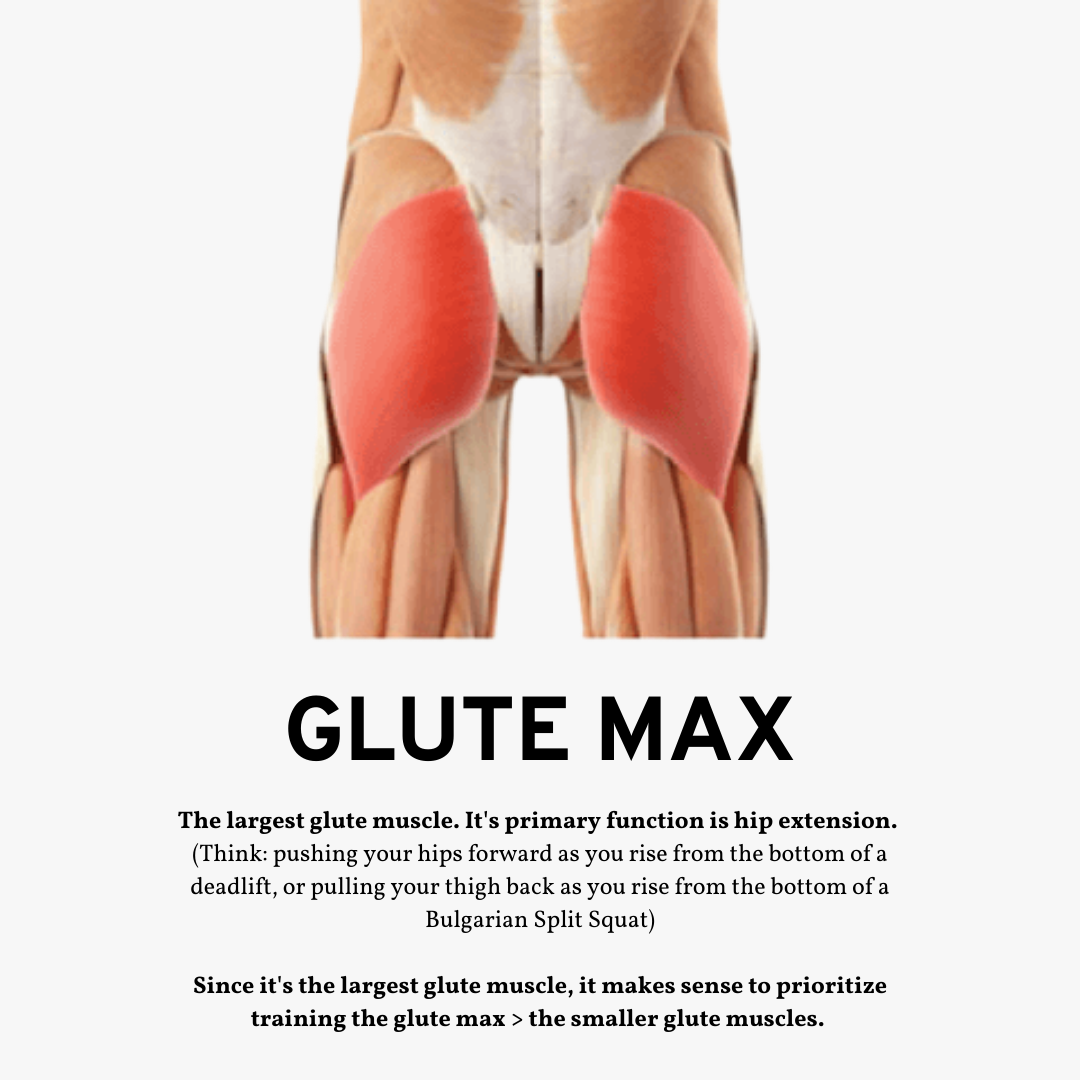
2. The glute med. This provides the "shelf" appearance to your glutes. If you feel like you don't have much "density" to your hips, building the glute med will help.
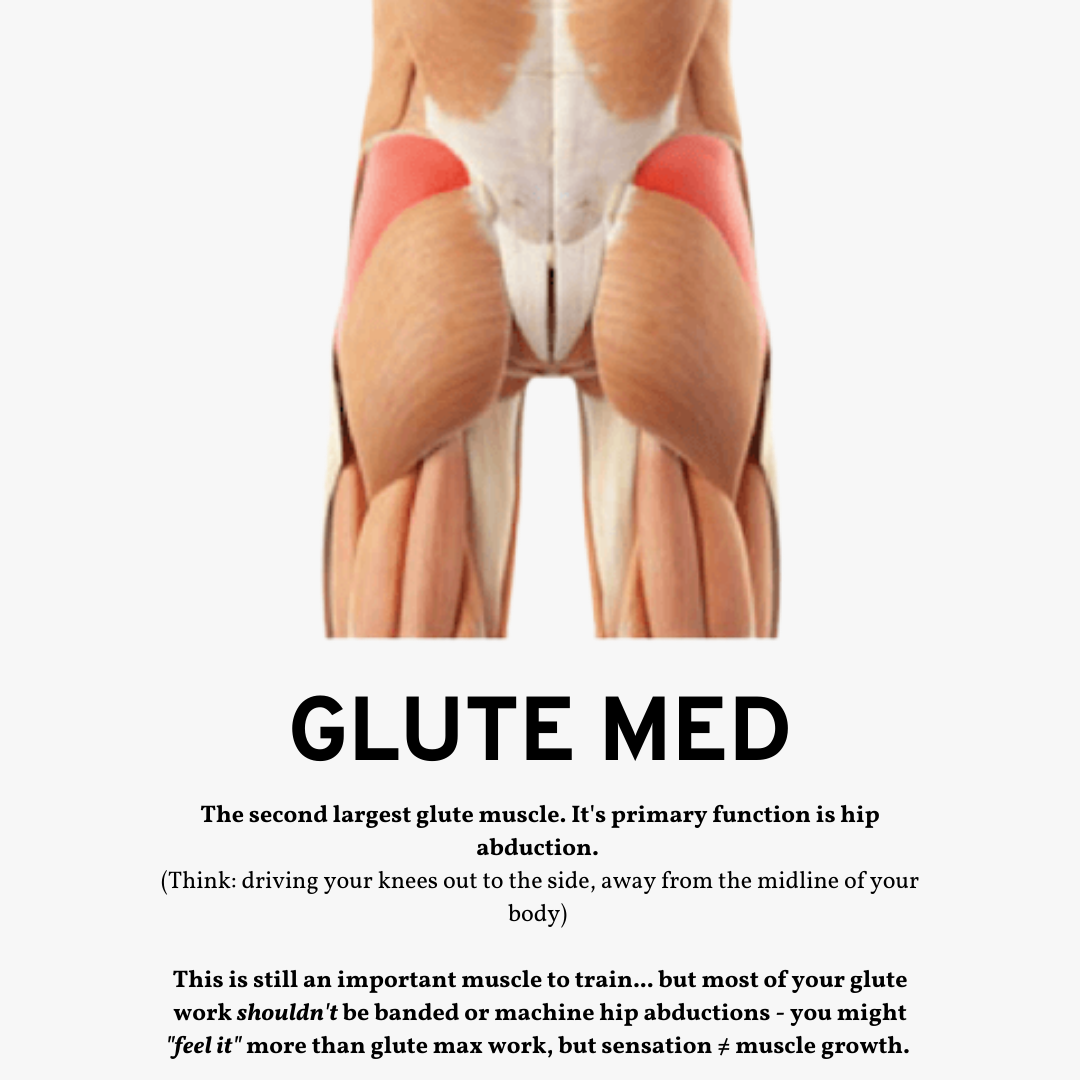
Another muscle that's helpful to understand is the piriformis - a small muscle that a lot of women have issues with. This is a muscle that gets far too much attention when it comes to glute training, because it does provide a lot of sensation when trained.

For example, when doing a set in theseated hip abduction machine...
...it may seem like you feel a lot of tension in your glutes. But really, it's often your piriformis becoming inflamed and almost telling you "I've received too much attention, I don't need any more training".
So things like...
- Doing too much abduction specific work (i.e. seated hip abduction machine, band lateral walks)
- Doing lots of curtsy lunges
- Chronically externally rotating at the hip with movements like sumo deadlifts
...can lead to with piriformis pain.
It's important to understand here that while it may feel like your glutes are working a lot, you glutes are actually not going through much range of motion at all, you're just putting a lot of tension on the muscles around the glutes.
THE PRIMARY MUSCLE GROUPS TO FOCUS ON FOR GLUTE GROWTH
When it comes to building great glutes, we want to make the glute max a primary emphasis, as it's the biggest muscle of your glutes (and thus has the greatest potential for growth/creating visual change).
Basically, if you don't have well developed glute max, your butt will just look flat.
This means...
- Lots of hip hinging. N1 Education did a great job illustrating the plane the glute max works in with this illustration:
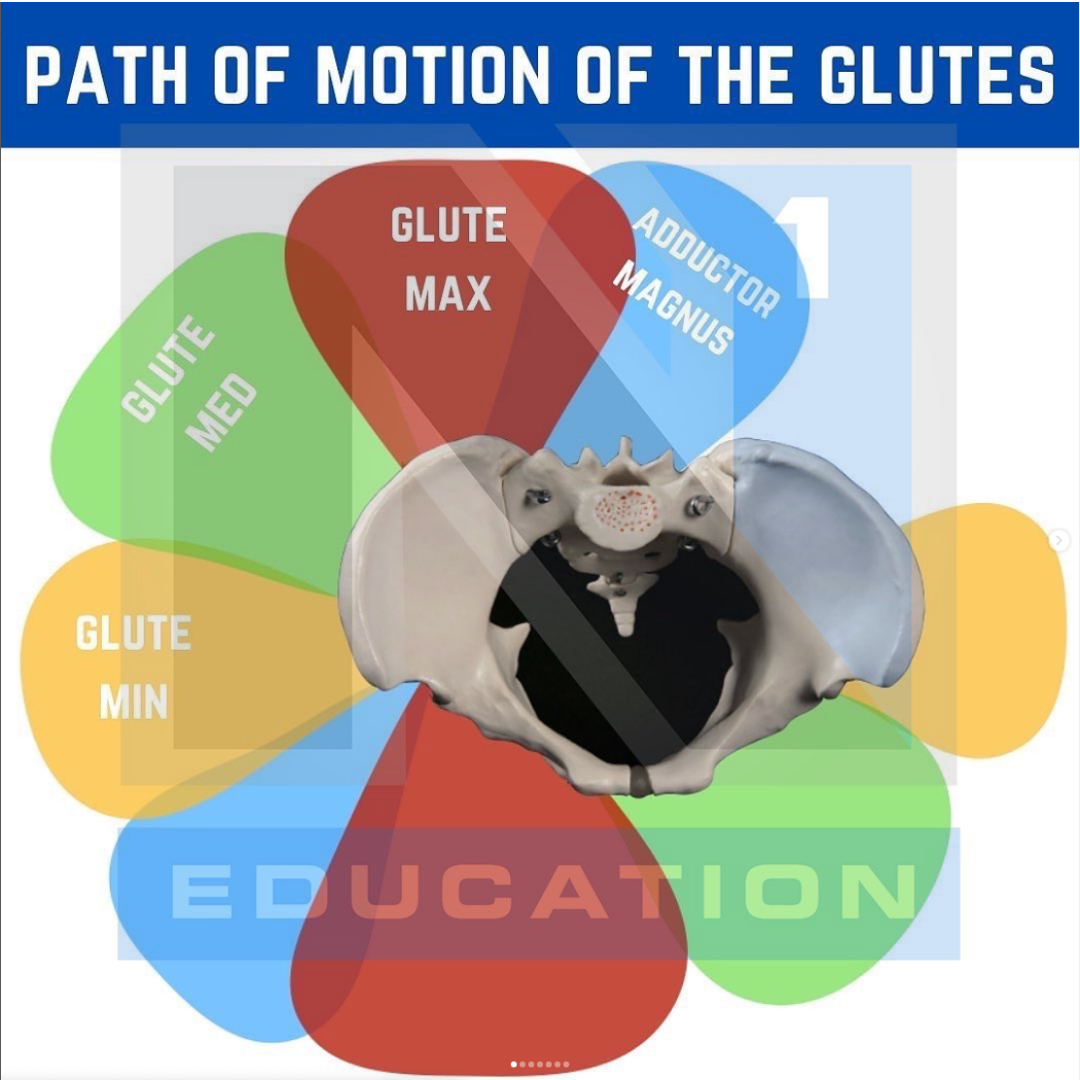
- Taking the glutes through a full range of motion when training them (I.e. going from hips flexed to hips extended, as shown below):
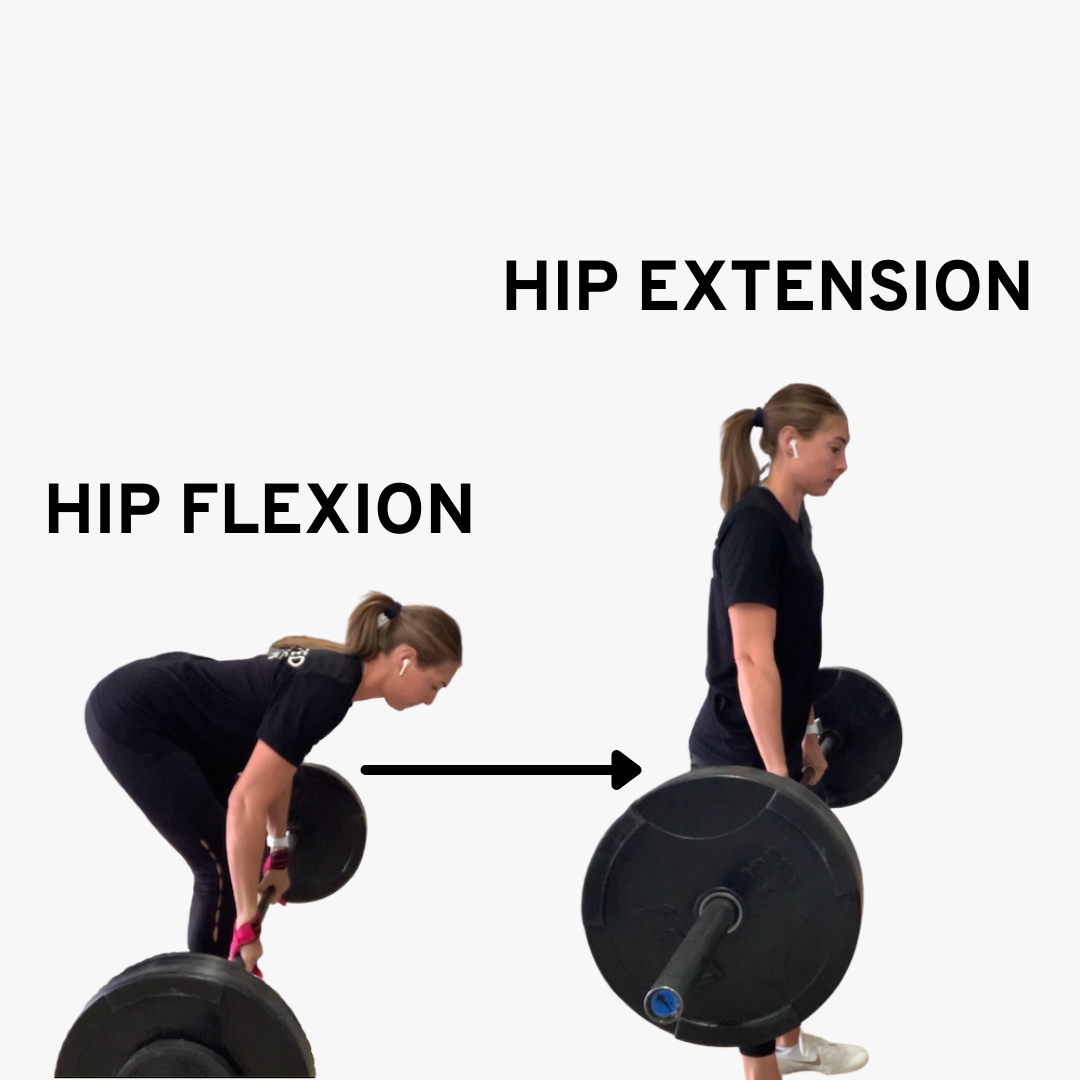
- Implementing movements that overload the glute max in both the lengthened and shortened positions:
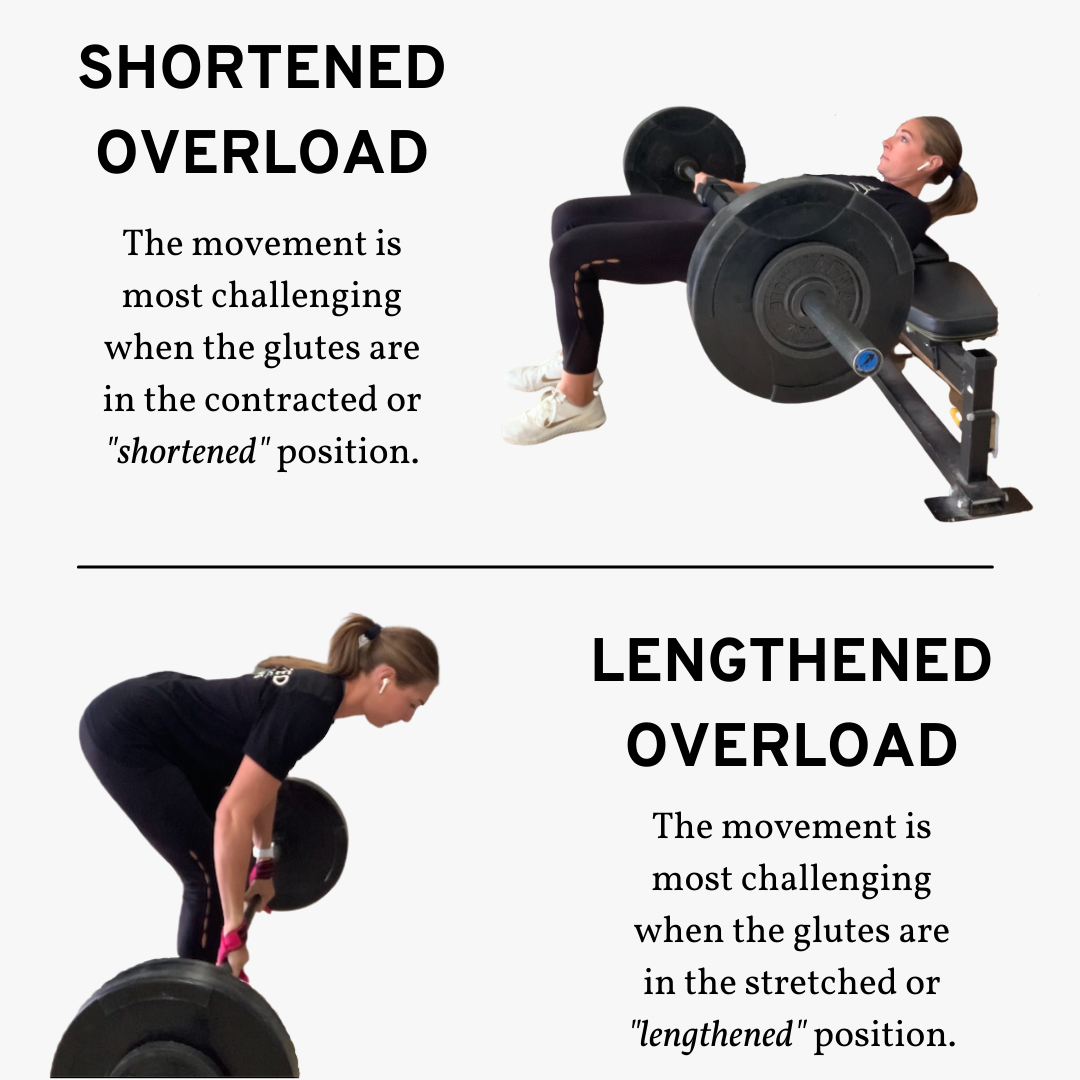
Great examples of movements for the glute max that overload the lengthened position:
- Romanian Deadlifts
- Glute Focused Leg Presses
- Lunge variations
- Rear Foot Elevated Split Squats
- Glute Biased Back Squat
Great examples of movements for the glute max that overload the shortened position:
- Glute Bridges
- Hip Thrusts
- 45 Degree Hip Extensions
- Kickback Variations
MOVEMENT EXECUTION FOR GLUTE MAX BIAS
It's important to understand that how you execute a movement will impact what muscle tissue we're biasing.
For example, with the Romanian Deadlift we have a few different ways we can execute the movement that will change what muscle group we're biasing:
1. Bent Knee Romanian Deadlifts
Allowing the knee to bend a bit more with this variation allows. us to achieve more hip flexion, meaning you can drive the hips back further and lengthen the glutes more.
So this variation is better for biasing the glute max.
2. Stiff Leg Romanian Deadlifts
Here, we're not going to be able to push our hips back as far/achieve as much hip flexion, because we're limited by the mobility of the hamstring and gastroc, which will lead to more hamstring and less glute bias.
That said, understand that when we're talking about biasing specific muscle groups, it's not like a light switch where because we're biasing the glutes, the hamstrings are entirely "off".
It's much more like a dimmer/brighter knob - when we're biasing the glutes, that knob is turned brighter, but the hamstrings aren't totally off, just a bit dimmer.
Similar to the above example, in a split squat or lunge variation, we're focusing much more on the hip hinge/pushing the hips back and allowing the glutes to lengthen vs. driving the knee forward/bending lots at the knee like we would if we were trying to bias quads.
A great example of this is a glute biased split squat vs. a quad biased split squat:

PROGRAMMING CONSIDERATIONS FOR GLUTE GROWTH
One primary factor you need to consider with your here is the degree of spinal loading, and how much fatigue you currently have the capacity to recover from.
Movements that involve a large amount of axial loading (load on the spine) are as a whole more stressful/fatiguing for your body, and thus require more "recovery resources" to actually recover/grow from them.
Now, this absolutely isn't to say that you should avoid movements that load the spine to a significant degree... because many of them are going to be great movements for building glutes. You just need to be smart in the way you program them.
Say that in your lower body training day, the first movement that you did was a Romanian Deadlift. While great for glutes, this movement also involves a good amount of axial loading.
So if you wanted to make the next movement you did glute biased as well, doing something like a glute focused leg press would be a great option - you'll still be able to significantly challenge the glutes, and won't have the heavy axial loading that came with the first movement. Fatigue will be lower, and performance likely higher.
Basically, the amount of fatigue we create in the first movement can inhibit performance in the second movement if we're not smart with exercise selection here.
VOLUME ALLOCATION
To revisit our discussion from earlier about lengthened vs. shortened overload glute movements...
Great examples of movements for the glute max that overload the lengthened position:
- Romanian Deadlifts
- Glute Focused Leg Presses
- Lunge variations
- Rear Foot Elevated Split Squats
- Glute Biased Back Squat
Great examples of movements for the glute max that overload the shortened position:
- Glute Bridges
- Hip Thrusts
- 45 Degree Hip Extensions
- Kickback Variations
Alex recommended that when trying to determine how many lengthened vs. shortened overload movements you should program in a week ok training:
- 75% lengthened biased movements / 25% shortened biased movements is a decent starting point.
- If you struggled to recover from this, you could start to transition to something closer to a 50/50 split between the two.
It's also important to understand that this should vary based on what phase of nutrition you're in.
In a building phase, clients will often have more lengthened biased work and less shortened biased work because lengthened overload movements are both more stimulative for muscle growth and use more of your recovery resources. So it makes sense to do more of these when you're eating plenty of food and focusing on building new glute tissue.
In a fat loss phase, clients will sometimes be doing a bit more shortened emphasis work to make sure that you can actually still recover from your training.
So an example of this this in a lower body day could look something like:
- Bent Knee RDL (lengthened)
- Glute Biased Leg Press (lengthened)
- Glute Med Kickback (shortened)
- 45 Degree Hip Extension (shortened)
For a more advanced individual, we could incorporate a third lengthened overload movement here, but it's not often going to actually be needed.
(*NOTE: This is just the glute specific work from a lower body day, not the entire lower body day. We would also want to include some quad and hamstring biased work).
For most people, it probably makes the most sense to keep the number of glute biased movements to 3-4 per training day that seem to work very well for you, and perform those with more sets vs. doing lots of different movements with less sets.
So in a hypertrophy phase, we would often set this up something like:
1. Lengthened overload movement
2. Lengthened overload movement
3. Shortened overload movement
If we were to put the shortened movement in the middle of the two lengthened movements, performance on the final lengthened movement would likely suffer as fatigue will already be high.
But when we're moving from lengthened → lengthened → shortened, we'll have created a lot of fatigue in the lengthened state, but will still have some gas in the tank when it comes to training the shortened range, as it hasn't been trained too heavily yet.
HOW FREQUENTLY SHOULD YOU TRAIN YOUR GLUTES?
Like most things within coaching, this should be dependent on you as an individual.
First, where are you at with your ability to create significant tension in your glutes when training?
If you're struggling to execute most movements in a manner that will effectively create significant tension in your glutes, it could make sense to train glutes more frequently (but with less overall volume per session) to be able to frequently "practice" these movements and get your execution in a good place for glute growth.
For these individuals, training your glute focused movements 3x/week could make sense for a short period of time could make sense.
But for those that do have good execution/ability to create glute tension, Alex mentioned that he'll typically start clients chasing glute gains out with glutes being trained two days per week. Volume (number of hard sets) can be as low as ~12-15 hard sets across all glute focused movements, and can climb all the way up to 20-22 hard sets per week for a more advanced individual in a building phase.
ALEX'S TOP GLUTE MOVEMENTS
1: Glute Emphasis Rear Foot Elevated Split Squat
2: Bent Knee Romanian Deadlifts
3: Barbell Glute Bridge
4: Glute Biased Leg Press or Back Squat
5: Glute Biased Step-Up or Reverse Lunge
6: 45 Degree Hip Extension
FOLLOW ALEX & HIS CONTENT:
→ TikTok
→ Physique Development YouTube
→ Podcast
If you found this helpful but need some help creating a personalized training and nutrition plan to hit your physique goals, click here now to schedule a free discovery call with our coaching team.
Keep Learning

Food Quality Vs. If It Fits Your MacrosProject type

How To Set (And Adjust) Your Macros For Any GoalProject type

The Ultimate Guide To Flexible DietingProject type

The Fat Loss GuideProject type

How To Fix Stalled Fat LossProject type

The Best Diet To Lose Weight Postpartum - backupProject type

How To End A Diet (Without Losing Your Results)Project type

The Best Diet To Lose Weight PostpartumProject type

The 5 Keys To Maintaining Weight Loss ForeverProject type

How To Use Nutrition Periodization For Fat LossProject type

5 Ways To Get (and stay) MotivatedProject type

The Best Exercises For Building GlutesProject type

How To Hit Your Macros While TravelingProject type

The 6 Keys To Building Muscle For WomenProject type

Mom Of Five Photoshoot Prep (Nutrition Protocol, Training Strategy, Macro Adjustments, And More)Project type

Why Your Macros Aren't Working For Fat LossProject type

The Best Nutrition Strategy For Building MuscleProject type

Should You Bulk Or Cut First?Project type

Mom Of Five Photoshoot Prep (Nutrition Protocol, Training Strategy, Macro Adjustments, And More) - backupProject type

How To Sleep For Muscle Growth & Fat LossProject type

The Stubborn Muscle Solution For Your Delts, Quads, Hamstrings, and Back (Finally See Growth!)Project type

[GUIDE] The Best Diet To Get Lean In 12 WeeksProject type

Thyroid Health 101Project type

How To Change Your Body Fat Set PointProject type

The Core Training BlueprintProject type

How To Minimize Hunger On A DietProject type

Do You Need To Reverse Diet? [When/Why/How]Project type

The Ultimate Guide To PowerbuildingProject type

[GUIDE] How To Do Your First Pull-UpProject type

Building The Female PhysiqueProject type

Nutrition For Aesthetics [Beyond The Basics]Project type

The Definitive Guide To Periodizing NutritionProject type

The Ultimate Mini Cut Guide [Rapid Fat Loss]Project type

[Peak Week Guide] How To Get Photoshoot ReadyProject type

The Rapid Fat Loss ProtocolProject type

The 6 Worst Nutrition Mistakes You're MakingProject type

The Shoulder Training BlueprintProject type

Diet Breaks 101 (What/Why/How)Project type

CALORIE CYCLING 101: 6 Methods To Get You LeanerProject type

HORMONES: Are They Killing Your Results?Project type

The Complete Guide To Getting Visible AbsProject type

The P3 Fat Loss MethodProject type

How To Fix Your Gut Health & DigestionProject type

[Client Case Study] Achieving Lifestyle LeanProject type

How To Find Your Ideal DietProject type

Is Insulin Making You Fat?Project type

Why Fat Loss Stalls [And What To Do]Project type

The Complete Guide To Training At HomeProject type

The Body Composition Change BlueprintProject type

The 6 Most Helpful Things I've Learned In The Last Year [Training, Nutrition, & Coaching]Project type

[Program Design Masterclass] The Full Body SplitProject type

[GUIDE] How To Avoid Holiday Fat GainProject type

Do You Need To Reverse Diet?Project type

How To Stay Lean While Traveling/On VacationProject type

Client Case Study: 6 Months To Photoshoot LeanProject type

[GUIDE] Beat The Skinny-Fat PhysiqueProject type

[10 TIPS] How To Stay Lean For LifeProject type

[KEY TO CLIENT SUCCESS] The Motivation ManualProject type

[GUIDE] The Core Training BlueprintProject type

Fat Loss For Women: The Complete GuideProject type

How To Get Bigger ArmsProject type

Strategies To Make Dieting Suck LessProject type

Dealing With Fat Loss StallsProject type

Compound Exercises vs. Isolation ExercisesProject type

Are Any Supplements Worth The Cost?Project type

7 Diet & Nutrition Tips For Fitness And HealthProject type

Is The Fitness Industry Full of Lies?Project type

The Lean Gains BlueprintProject type

My 3 Favorite Movements For Each Muscle GroupProject type

Can You Grow Your Calves or Is It All Genetics?Project type

The BEST Diet For Rapid Weight LossProject type

Does Eating Red Meat Cause Cancer?Project type

EVERYTHING You've Heard About Fat Loss Is A LIE.Project type

Is It Harder For Women To Get Abs?Project type

How To Get Toned ArmsProject type

How Often Should I Go To The Gym?Project type

How To Prioritize Cardio Vs. WeightliftingProject type

Does Gut Health Effect Weight Loss?Project type

Are Group Fitness Classes Effective?Project type

A Beginner's Guide To Intermittent FastingProject type

Can't Do A Chin-Up? Do This FirstProject type

Best Exercises For Defined ShouldersProject type

Fix Your Back PainProject type

Why can't I gain more muscleProject type

How to build great bicepsProject type

How to get AbsProject type

How to end a diet (without losing your results)Project type

The Best Diet To Lose Weight PostpartumProject type

The 5 Keys To Maintaining Weight Loss ForeverProject type



